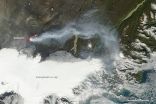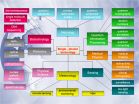(Press-News.org) A joint NOAA/NASA satellite is one of several satellites providing valuable information to aviators about volcanic hazards. An aviation "orange" alert was posted on August 18, 2014, for Bárðarbunga, a stratovolcano located under the Vatnajökull glacier in Iceland, indicating the "volcano shows heightened or escalating unrest with increased potential of eruption."
Much of the information leading to that alert came from satellites including Visible Infrared Imaging Radiometer Suite (VIIRS) instrument on board the National Oceanic and Atmospheric Administration (NOAA)/NASA Suomi National Polar-orbiting Partnership (Suomi NPP).
While the Vatnajökull ice cap and its seismic activity has been gradually increasing over the past seven years, these recent events in Iceland are reminiscent of the destructive aftermath from the 2010 eruption of the Eyjafjallajökull volcano in Iceland. The Eyjafjallajökull eruption caused a six-day travel ban over the controlled airspace of many European countries. Data from NOAA satellites were used in the volcanic ash detection and property retrieval algorithm to create products to be used by the Volcanic Ash Advisory Centers (VAAC), including the London VAAC. The data given to the air traffic control organizations provided the information they needed to make the decision to divert and ground more than 4,000 flights. The ban was in effect to address the possibility of volcanic ash ejection causing damage to aircraft engines and risking human life. This was the largest air-traffic shut down since World War II, costing $1.7 billion in losses for the airline industry, as well as innumerable losses within freight imports and exports; tourism industries and the access to fresh food and essential goods.
Recently, Mike Pavolonis, is a NOAA scientist from the Center for Satellite Applications and Research (STAR) presented his work on How Weather Satellites are Mitigating Aviation-related Volcanic Hazards during a NOAA event. "Only 10 percent of the world's volcanoes are routinely monitored from the ground, making satellites the only frequently available tool that can reliably identify volcanic eruptions anywhere in the world," Pavolonis said. Advanced analysis of data from polar orbiting and geostationary satellites reduces the probability of a disastrous and/or costly aircraft encounter with volcanic ash and helps to minimize the cost associated with avoiding volcanic ash.
NOAA operates two of the nine Volcanic Ash Advisory Centers - the Anchorage Alaska VACC and the Washington VAAC - that provide operational support to the aviation sector to warn about these hazards for over a decade. He highlighted how volcanic ash can severely impact air travel, melting in a plane engine's combustion chamber and even shutting the engine down completely. This occurred in June 1982, when a British Airways B747 aircraft flew into a volcanic ash cloud from Mount Galunggung (Indonesia) and lost power in all four engines. They dropped from 37,000 feet to 12,000 feet before three engines were restarted and the plane was able to make an emergency landing in Jakarta, Indonesia.
The pilots were unable to see the ash on their radar. Thick, billowing ash clouds from volcanoes often spread out over large areas—well beyond the erupting volcano. Aircraft close calls with volcanic ash have continued over the years. In 2011, U.S. Secretary of State, Hillary Clinton had to cut short a three-nation tour of Africa following a volcano eruption that created an ash cloud over parts of East Africa. These high profile events motivate the work to provide volcanic ash warnings as early as possible after an eruption.
The STAR volcanic ash algorithm takes data from satellites to create actionable information that can assist in advanced warning of volcanic eruptions and ash detection. The addition of the VIIRS instrument aboard the NOAA/NASA Suomi NPP satellite to the STAR volcanic cloud analysis system, has proven to be vital for detecting and characterizing small scale thermal signatures and clouds associated with volcanic activity. These thermal signals can be a precursor to an explosive eruption.
The VIIRS instrument is suited to detect the relatively unique spectral signature difference of volcanic clouds often absorb and reflect radiation as a function of wavelength in a manner that is very different from other cloud types. Future plans include incorporating information from Suomi NPP's Cross-track Infrared Sounder and the Ozone Mapping and Profiler Suite instruments into the algorithm.
NOAA's polar satellites are critical for a variety of "nowcasting" capabilities in addition to volcanic ash including imagery to monitor storms, fog, sea ice, and other dangerous weather and environmental conditions as well as providing data for more accurate weather forecasting to secure a more 'Weather-Ready Nation' thereby saving lives and protecting property.
INFORMATION:
For more information and statistic about volcanic ash detection, visit: http://www.star.nesdis.noaa.gov/goesr/product_aero_vol.php
For more information about the Suomi NPP satellite, visit: http://www.nasa.gov/NPP or http://www.nesdis.noaa.gov/npp_launch.html
Suomi NPP satellite data used for mitigating aviation related volcanic hazards
2014-09-26
ELSE PRESS RELEASES FROM THIS DATE:
Mechanized human hands: System designed to improve hand function lost to nerve damage
2014-09-26
CORVALLIS, Ore. – Engineers at Oregon State University have developed and successfully demonstrated the value of a simple pulley mechanism to improve hand function after surgery.
The device, tested in cadaver hands, is one of the first instruments ever created that could improve the transmission of mechanical forces and movement while implanted inside the body.
After continued research, technology such as this may offer new options to people who have lost the use of their hands due to nerve trauma, and ultimately be expanded to improve function of a wide range of damaged ...
Biochemists solve 'address problem' in cells that leads to lethal kidney disease
2014-09-26
Research by UCLA biochemists may lead to a new treatment — or even a cure — for PH1, a rare and potentially deadly genetic kidney disease that afflicts children. Their findings also may provide important insights into treatments for Parkinson's disease, Alzheimer's disease and other degenerative diseases.
Led by Carla Koehler, a professor of chemistry and biochemistry in the UCLA College, the researchers identified a compound called dequalinium chloride, or DECA, that can prevent a metabolic enzyme from going to the wrong location within a cell. Ensuring that the enzyme ...
Single-photon detection, generation, and applications featured in Optical Engineering
2014-09-26
BELLINGHAM, Washington, USA – A new special section on single-photon detection, generation, and applications in Optical Engineering highlights research on technologies with applications in areas as diverse as space exploration and quantum computing, furthering the field by providing more accurate measurement methods and new analysis techniques. The peer-reviewed journal is published by SPIE, the international society for optics and photonics, in print and in the SPIE Digital Library.
The section appears in the August issue, and include nine articles and an editorial outlining ...
No sign of health or nutrition problems from GMO livestock feed, study finds
2014-09-26
A new scientific review from the University of California, Davis, reports that the performance and health of food-producing animals consuming genetically engineered feed, first introduced 18 years ago, has been comparable to that of animals consuming non-GE feed.
The review study also found that scientific studies have detected no differences in the nutritional makeup of the meat, milk or other food products derived from animals that ate genetically engineered feed.
The review, led by UC Davis animal scientist Alison Van Eenennaam, examined nearly 30 years of livestock-feeding ...
Exploring the connection between empathy, neurohormones and aggression
2014-09-26
Empathy is typically seen as eliciting warmth and compassion—a generally positive state that makes people do good things to others. However, empathy may also motivate aggression on behalf of the vulnerable other. Researchers at the State University of New York at Buffalo, examined whether assessed or elicited empathy would lead to situation-specific aggression on behalf of another person, and to explore the potential role of two neurohormones in explaining a connection between empathy and aggression. The study is published in Personality and Social Psychology Bulletin. ...
Discrepancies in access to new cancer drugs revealed
2014-09-26
Access to potentially life-extending cancer drugs varies significantly in different regions of the world, two new studies show at the ESMO 2014 Congress in Madrid, Spain.
Researchers say the results demonstrate the need for better collaboration between doctors and health authorities on an international scale, to ensure patients have access to the best treatments.
Coordinated action is needed at an international level to ensure new cancer-fighting drugs are approved in a timely manner, oncologists said at the Congress. Their call came after a survey revealed that patients ...
Protein 'map' could lead to potent new cancer drugs
2014-09-26
Imperial chemists have gained fresh insights into how a disease-causing enzyme makes changes to proteins and how it can be stopped.
The scientists hope their findings will help them to design drugs that could target the enzyme, known as N-myristoyltransferase (NMT), and potentially lead to new treatments for cancer and inflammatory conditions.
They have already identified a molecule that blocks NMT's activity, and have identified specific protein substrates where this molecule has a potent impact.
NMT makes irreversible changes to proteins and is known to be involved ...
More than 70 percent of young oncologists in Europe suffer symptoms of burnout
2014-09-26
Across Europe, more than 70% of young cancer specialists are showing signs of burnout, the largest survey of its kind has revealed. The results, reported at the Congress of the European Society for Medical Oncology (ESMO 2014) in Madrid, have prompted calls for serious action to address the issue at all levels.
"Oncology is an exceptionally rewarding career, but it can be demanding and stressful at times," said Dr Susana Banerjee, lead author of the study and a consultant medical oncologist at The Royal Marsden NHS Trust in London, UK.
"Oncologists make complex decisions ...
The discovery of 27 vertebrates fully reveals the unmatched biodiversity in Tanzania
2014-09-26
A study by an international team of scientists coordinatedby Italy's MUSE - Science Museum updates knowledge on the faunal richness of the Eastern Arc Mountains of Tanzania and Kenya; presents the discovery of 27 new vertebrate species (of which 23 amphibians and reptiles); identifies the drivers of the area's exception biological importance and advocates for its candidature to the UNESCO's List of World Heritage Sites.
A study documenting the latest research findings on the faunal richness of the tropical moist forests of the Eastern Arc Mountains of Kenya and Tanzania ...
Turmeric compound boosts regeneration of brain stem cells
2014-09-26
A bioactive compound found in turmeric promotes stem cell proliferation and differentiation in the brain, reveals new research published today in the open access journal Stem Cell Research & Therapy. The findings suggest aromatic turmerone could be a future drug candidate for treating neurological disorders, such as stroke and Alzheimer's disease.
The study looked at the effects of aromatic (ar-) turmerone on endogenous neutral stem cells (NSC), which are stem cells found within adult brains. NSC differentiate into neurons, and play an important role in self-repair and ...




